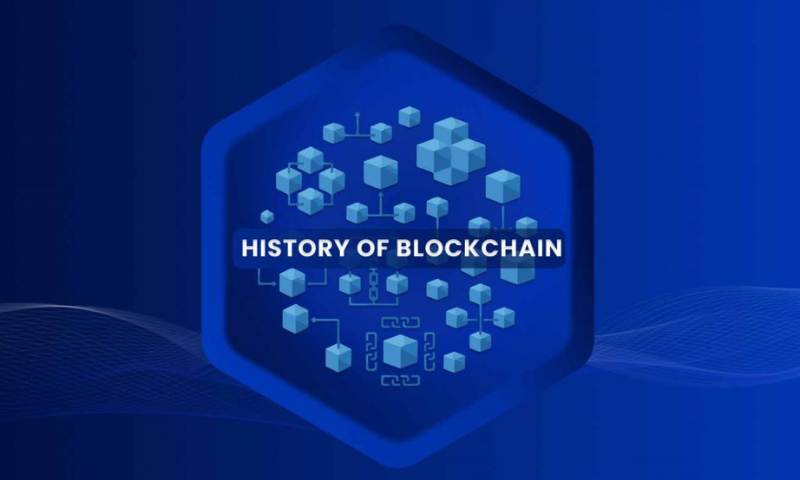History of Blockchain: It’s not just a geek’s tale, it’s a saga that transformed how we see money and business. I’ll walk you through its roots, from a clever idea to a tech revolution. Discover what sparked the digital ledger boom. This story is about breaking chains and coding new ones—not in basements, but in the world’s spotlight. Buckle up for a ride through digital history that’s rewriting the rules. What started this wave? A ghost named Satoshi and a paper that turned heads. From there, a network that spread like wildfire. Get ready—let’s dive into how blockchain began!
The Inception of Blockchain and the Emergence of Cryptocurrency
The Brainchild of Satoshi Nakamoto: From the Bitcoin Whitepaper to Cryptocurrency Genesis
Let’s dive into a tech time travel tale. The year was 2008. Enter Satoshi Nakamoto, a name wrapped in mystery. But who is Satoshi? No one knows for sure. What we do know is that Satoshi brought us the Bitcoin whitepaper. This paper was the seed from which a mighty tree would grow. It showed us a system for digital cash, and the world took notice.
“Folks, we can send money, direct to others, no banks needed,” Satoshi might have said. Just like that, the first cryptocurrency—Bitcoin—was born. But Bitcoin wasn’t just about cash. It was the first to use what we call a blockchain.
Charting the Origins: Distributed Ledgers and the First Public Blockchain
Before we had Bitcoin’s blockchain, we had research on secure records. These were called “distributed ledgers.” Picture many shared books, all the same, all over the place. They’re tough to fool because you’d have to change all the books, and quickly! That’s some superhero-level stuff.
Now, real quick, what’s blockchain? It’s like a chain of digital blocks. Each block holds a list of records. Every new block gets added to the chain in a way that’s very secure. This is where hash functions in blockchain come into play. They’re like secret codes that protect the data.
This technology isn’t just smart; it’s fair too. That’s thanks to blockchain consensus mechanisms. They’re rules that help everyone agree without fighting. Proof of work was the first way we did this. It’s like saying, “I did a ton of work, so you can trust this new block.”
Turns out, Satoshi kickstarted a tech revolution. Money had evolved, and we were all invited. Cryptocurrency genesis had begun. After Bitcoin came hundreds of digital coins. They brought different features, but all shared the dream of changing money forever.
The beauty of this early blockchain application? It gave us trust in a trustless world. You didn’t need to trust a person. Instead, you trusted math, and math doesn’t lie. Peer-to-peer networks, that’s just tech speak for people connecting directly, made this possible.
From here, the blockchain technology timeline rocketed. Satoshi’s vision now sparked countless projects and ideas. In the wild world of tech, this was the equivalent of the Big Bang. And guess what? This was just the start.
Hang tight, friends. This history ride of blockchain has more thrilling stops ahead. We’re talking Ethereum and smart contracts, the twists and turns of blockchain forks, and the wild tales of initial coin offerings (ICOs). We’ll see the rise of the blockchain’s use in everything from catching bad guys to tracking tomatoes.
So, that’s the scoop on the early days of blockchain and the crypto explosion. It’s a story of ideas, mystery, and a whole new kind of money. From the Bitcoin whitepaper to the cryptocurrency swarms we have now, it’s all about connection, fairness, and security. It’s a digital ledger revolution—no going back now.
Advancements in Blockchain: Beyond Bitcoin
Smart Contracts Evolution and the Entry of Ethereum
Blockchains got smarter with Ethereum. It took us beyond Bitcoin’s money talks. Ethereum showed up with a new trick: smart contracts. Smart contracts are just like vending machines. You pick a snack, pay the right amount, and the machine gives you what you chose. Here, the machine is a computer program that runs on blockchain.
Ethereum uses these contracts to automate deals. No more middlemen; just code that does what it’s told. Vitalik Buterin started Ethereum, and it changed the game. It let us make our own rules for how money moves and who can touch it. This was a big leap in how we use blockchain.
The Sprouting of Altcoins and the History of Blockchain Forks
As time passed, new coins popped up like mushrooms. They’re called altcoins, short for alternative coins. Each one has its own twist on what Bitcoin does. You’ve got Litecoin, which is like Bitcoin but lighter and faster. There’s also Ripple, which makes banks pals with blockchain.
But sometimes, people in the Bitcoin family disagree. They can’t settle their fights in the code. So they split. This is called a fork. Imagine everyone is driving on the Bitcoin highway, and then a group decides to take a new exit and build a new road. That’s a fork. It’s how we got Bitcoin Cash and others.
Forks help us find new ways to use blockchain. They bring fresh ideas to the table. But they also make us stop and think. Which is the better way? What’s the real Bitcoin? These are the type of questions we face.
Blockchain has come a long way since Satoshi Nakamoto first told us about Bitcoin. We saw how smart contracts made Ethereum special. We watched altcoins grow and saw forks in the road. This story is not just about money. It’s about how we trust, share, and even fight. Each step has made blockchain what it is today. And this journey, it’s far from over. Let’s see where it takes us next.
The Maturation of Blockchain Technology
The Shift from Proof of Work to Proof of Stake in Pursuit of Scalability
Many ask, “What’s the big deal with proof of work versus proof of stake?” It’s simple: better speed and energy use. Proof of work was king for a while. You may know it from Bitcoin. Computers solve puzzles to process transactions. This method is secure but very power hungry.
So, we needed a switch. Enter proof of stake. Here, owners of the coin keep the network safe. It’s like having a key to your own safe. You help run things smoothly and use much less energy. This switch is huge for blockchain. It gives us a shot at handling many more transactions at once.
Let’s get deeper into this. Proof of work made early blockchains like Bitcoin strong. But people saw a problem—it was slow and gobbled up energy. Imagine all of Las Vegas being lit up, just for Bitcoin mining. That’s too much! So, people started to look for new options.
Ethereum, a major blockchain, decided to change the game. It moved from proof of work to proof of stake with its update called “Ethereum 2.0.” The promise is big: faster transactions and less energy, like going from snail mail to email. It’s a big step for blockchains to grow and be better for our planet.
The Dawn of Decentralized Finance and Expanding Blockchain Applications
What started as a way to swap Bitcoin has now exploded. We now have decentralized finance, or DeFi for short. It’s a fancy way of saying we do money stuff without banks. Think loans, savings, and trading without waiting in line. It’s all run on blockchain.
We can thank Ethereum for a lot of this. It’s not just a coin; it’s a place where apps can live. Smart contracts made this possible. They’re like robot agreements that do things automatically on the blockchain. This change pushed blockchains way beyond just coins.
Let’s dive into that more. Before, if you wanted to borrow money, you’d need a bank. But with DeFi, you just use your crypto as a promise. You get the cash without all the paperwork hassle. It’s smart contracts that make it all work.
This isn’t just cool; it’s a new world of doing business. People anywhere can now get into financial moves that were once for the big guys. It’s like everyone got a VIP pass to Wall Street. And as more people get in on DeFi, we’ll see even more smart ways to use blockchain.
Sure, it’s complex. But just know blockchains are solving real-world problems. From sending money overseas to keeping records, it’s changing how we do things. Every day brings new ideas and apps on the blockchain. It’s a revolution, one smart contract at a time.
Blockchain’s Pervasive Impact and Future Directions
Blockchain Governance, Adoption, and Regulatory Interplay
Let’s talk about how blockchain grows and fits into our world. You see, it’s like when new players enter a game and the rules start to change. This is what happens with blockchain governance and laws. Sometimes, the rules keep blockchain safe. Other times, they help more people use it. Experts work hard to make these rules fair and to keep blockchain trusty.
Now, if you’re curious about when folks really began to use blockchain, it all kicked into gear with Bitcoin. And then, many jumped in. Schools, businesses, and even whole countries saw its shine. They all wanted a piece of the blockchain pie. As more people joined, new ideas popped up. That’s how we got to today, with blockchain touching so many parts of life.
Innovation Highlights: The Rise of NFTs and Enterprise Blockchain Solutions
Let’s dive into some cool things blockchain can do. Ever heard of NFTs? They’re like rare sports cards but digital. People buy and trade them online. They prove you own a one-of-a-kind digital goodie. NFTs are a fresh way that blockchain changes how we think about owning stuff.
And then there are the big companies. They found ways to track goods all over the globe. They use blockchain so everything stays honest and clear as home-made jelly. It’s really something, seeing big rigs and spreadsheets join the blockchain party. It shows that this tech isn’t just about coins. It’s a tool that can change our whole world of trade, and that’s just the start.
We started with Satoshi’s vision, seeing how Bitcoin began the crypto craze. Then, we explored how blockchain grew, moving past just coins, with smart contracts and new uses galore. What began with Bitcoin led to a tree of coins and ideas, like Ethereum’s smart contracts. We saw tech get better, with the shift from proof of work to proof of stake, making things run faster and smoother. DeFi showed us blockchain’s not just for money; it’s a tool that can change how we do all kinds of stuff. Lastly, we talked about how blockchain is everywhere, changing businesses and even art with NFTs. It’s not just tech talk; real rules and choices shape the future of blockchain. As for what’s next, the sky’s the limit. Blockchain’s journey is an epic one, and we’re still on the ride.
Q&A :
What Is Blockchain Technology and How Did It Begin?
Blockchain technology is known as a decentralized ledger system that gained prominence with the introduction of Bitcoin in 2009. It was created by an individual or group of people under the pseudonym Satoshi Nakamoto. The idea was to establish a secure, transparent, and tamper-proof system for recording transactions without the need for a central authority.
Who Invented the Blockchain and What Was the Initial Purpose?
Blockchain technology’s origins trace back to Nakamoto, whose intent was to create a peer-to-peer electronic cash system that would operate securely without a central institution. The idea was to enable direct financial transactions between parties, ensuring security and trust through cryptographic principles and collective network verification.
How Has Blockchain Technology Evolved Since Its Inception?
Since its inception, blockchain technology has evolved significantly beyond just supporting cryptocurrencies. It has expanded into various sectors including finance, healthcare, supply chain, and more. Innovations like smart contracts and decentralized finance (DeFi) platforms showcase blockchain’s versatility and potential long-term impacts in numerous fields, striving for transparent and efficient processes.
What Are the Key Milestones in The Development of Blockchain?
Important milestones in blockchain development include the creation of Bitcoin in 2009 and the subsequent development of Ethereum in 2015, which introduced smart contracts. Other notable events are the ICO (Initial Coin Offering) boom of 2017, the integration of blockchain in enterprise solutions, and the ongoing exploration of its applicability in fields like identity verification, voting mechanisms, and Internet of Things (IoT).
What Is the Future Potential of Blockchain Technology?
The future potential of blockchain technology is vast and multifaceted. Its ability to create immutable records prompts its use in legal documentation, property records, and supply chain management. The continuous growth of DeFi and expansion into sectors like energy management and healthcare suggest a transformative impact on how businesses and governance could operate, stressing the focus on transparency, security, and efficiency.


